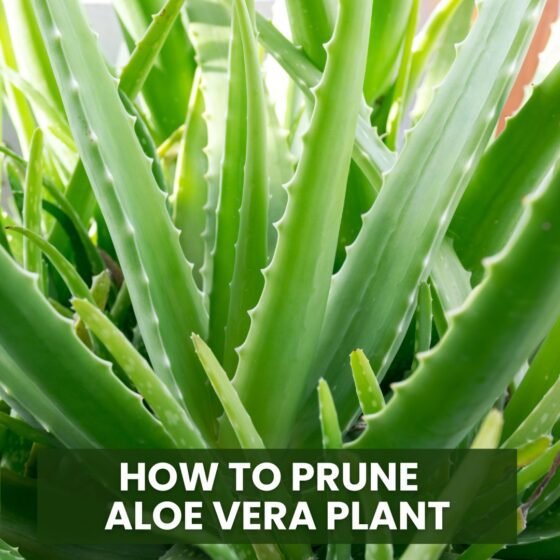Aloe Vera Care Mastery: How to Prune Aloe Vera Plant for Health and Growth
Aloe vera is a resilient and versatile succulent, valued for its medicinal properties, skin benefits, and low-maintenance nature.
However, to keep your aloe vera thriving, pruning is essential. Proper pruning removes damaged or old leaves, encourages new growth, and maintains the plant’s aesthetic appeal.
In this guide, you’ll learn how to prune aloe vera correctly to enjoy a lush, healthy, and productive plant all year round.

Understanding Why Pruning Aloe Vera Matters
Pruning aloe vera isn’t just about keeping it tidy. Removing dead, damaged, or crowded leaves helps the plant focus its energy on healthy growth.
Pruning also improves air circulation, reducing the risk of fungal infections and pest problems.
A well-pruned aloe vera plant looks fuller, grows stronger, and produces larger, more succulent leaves for harvesting.
Best Time to Prune Aloe Vera
The optimal time to prune aloe vera is during spring or early summer, when the plant is actively growing.
Avoid pruning in winter, as aloe enters dormancy and may struggle to recover. Timing your pruning correctly ensures faster healing and vigorous regrowth, giving you healthier leaves for use in skincare or home remedies.
Tools Needed for Aloe Vera Pruning
Using the right tools makes pruning easy and prevents plant damage. You’ll need sharp, clean scissors or pruning shears.
Avoid tearing leaves, as this can introduce infections. Disinfect tools with alcohol before and after use to maintain plant health. Proper tools also help you make precise cuts, keeping your aloe looking neat and healthy.
Step-by-Step Method to Prune Aloe Vera
-
Remove old or damaged leaves: Identify leaves that are brown, dry, or wilting. Cut them at the base to improve plant appearance and health.
-
Thin crowded areas: If multiple leaves are growing tightly together, trim some to improve airflow and prevent fungal growth.
-
Harvest mature leaves: Cut older, thick leaves for use in remedies, ensuring you leave enough younger leaves to sustain growth.
-
Trim flower stalks: If your aloe produces a flower stalk, snip it off after flowering to conserve the plant’s energy for leaf growth.
Following these steps helps your aloe vera grow bigger, healthier leaves while maintaining an organized structure.
Encouraging New Growth After Pruning
Pruning stimulates new leaf development, making your plant bushier and more vibrant.
To maximize growth, trim only the older leaves and avoid cutting too many at once.
Ensure the plant receives bright, indirect sunlight and moderate watering after pruning. These practices support a healthy aloe vera that regenerates quickly.
Pruning Aloe Vera in Containers
Container-grown aloe requires extra care when pruning. Since pots have limited soil, removing too many leaves at once can stress the plant.
Trim about one-third of the plant at a time and ensure proper drainage to prevent root rot.
Container aloe benefits from repotting every 2–3 years to maintain space for healthy root development and sustainable growth.
Seasonal Aloe Vera Care and Maintenance
Pruning should be part of your regular aloe vera care routine. In spring, prune to remove winter-damaged leaves.
During summer, perform light trimming to encourage continuous growth. In fall, remove older leaves to prepare the plant for winter dormancy. Consistent seasonal care keeps your aloe vera vibrant, resilient, and visually appealing.
Avoiding Common Pruning Mistakes
Even experienced gardeners can make errors when pruning aloe. Cutting too many leaves at once can shock the plant, slowing growth. Leaving dead leaves attached invites pests and diseases.
Overwatering after pruning can cause rot in freshly cut areas. Following careful pruning practices ensures your aloe vera remains healthy, strong, and productive.
Maximizing Aloe Vera Use Post-Pruning
Pruned leaves don’t have to go to waste. Mature leaves can be used for skincare, hair care, or homemade remedies, providing a continuous source of natural benefits.
Regular pruning encourages a steady supply of usable leaves while keeping the plant healthy and aesthetically pleasing.
Organic Tips to Support Aloe Vera Growth
Enhance pruning results by providing proper care. Use organic fertilizers or compost to enrich the soil.
Mulch around the base to retain moisture and keep roots cool.
Ensure the plant gets well-drained soil and adequate sunlight to thrive after pruning. These practices create an ideal environment for lush, thriving aloe vera plants.
Final Thoughts
Pruning aloe vera is a simple yet essential practice for maintaining a healthy, productive, and attractive plant.
By removing damaged leaves, timing your pruning correctly, and following seasonal care routines, your aloe will flourish year-round.
Proper pruning not only boosts growth but also provides a continuous supply of fresh, succulent leaves for all your home remedies and skincare needs.
With these steps, your aloe vera garden will thrive, offering beauty, health, and practicality in one succulent package.






